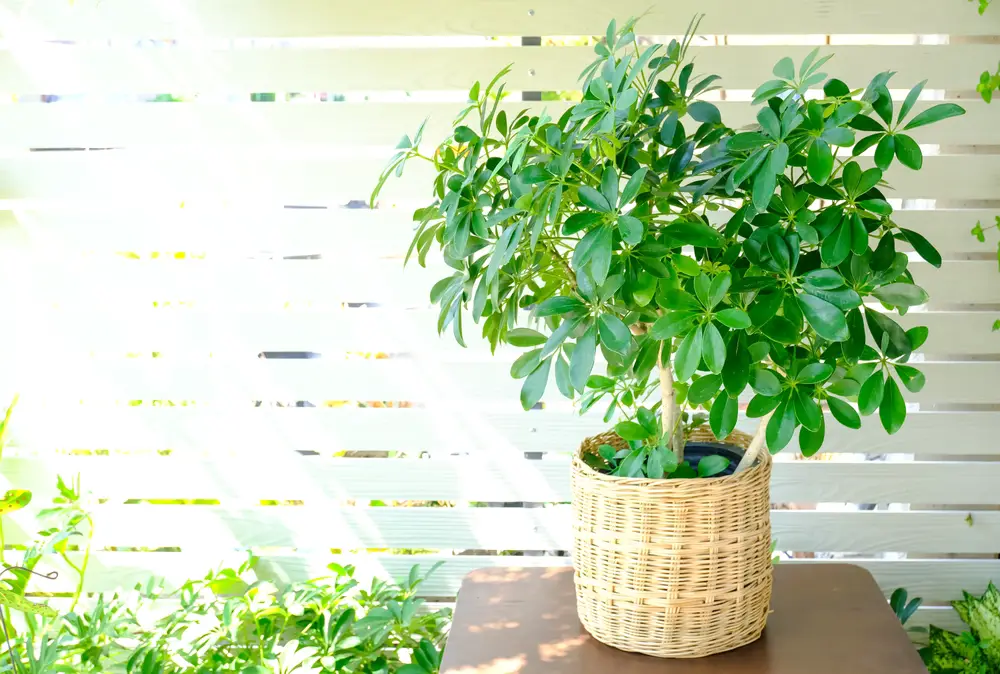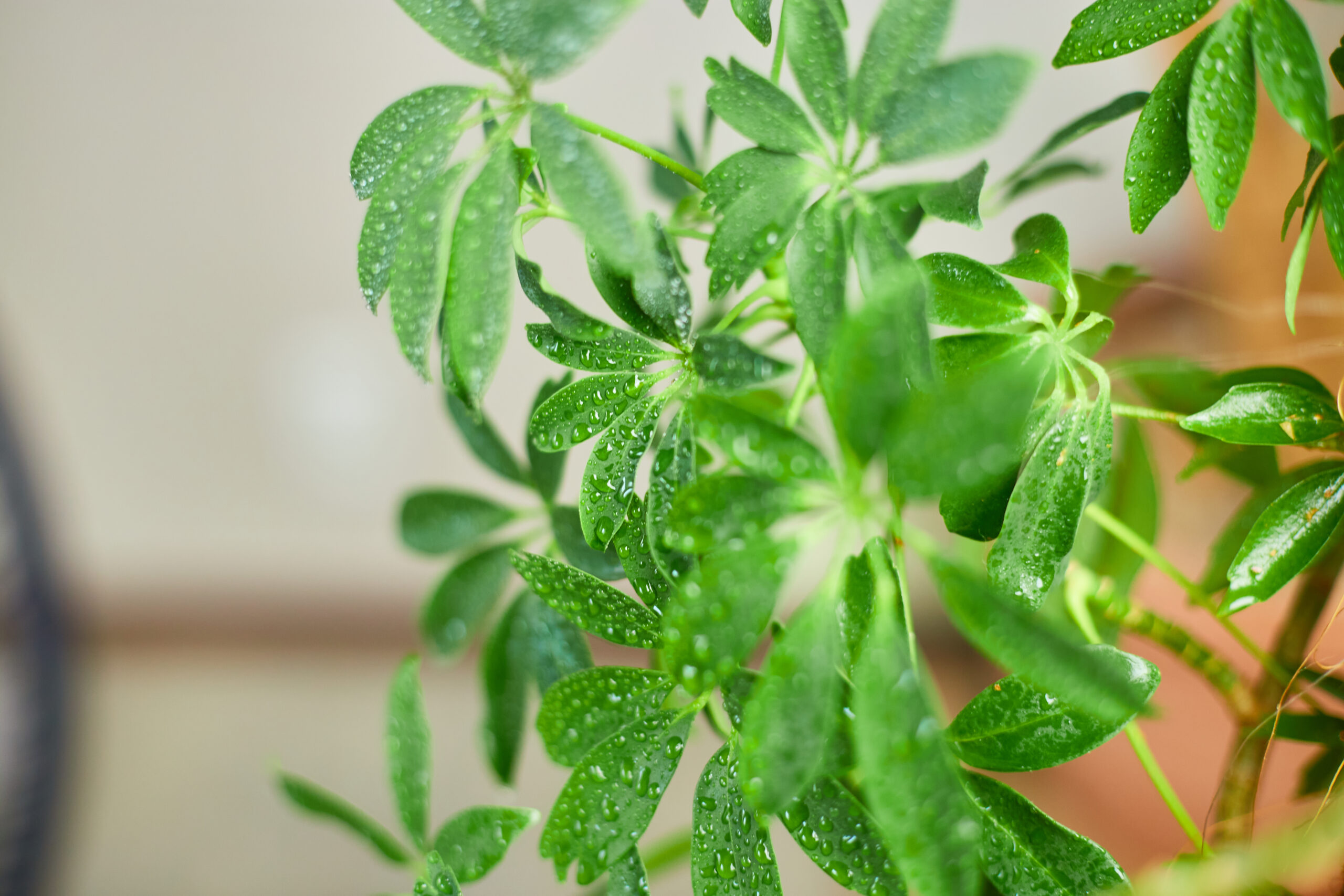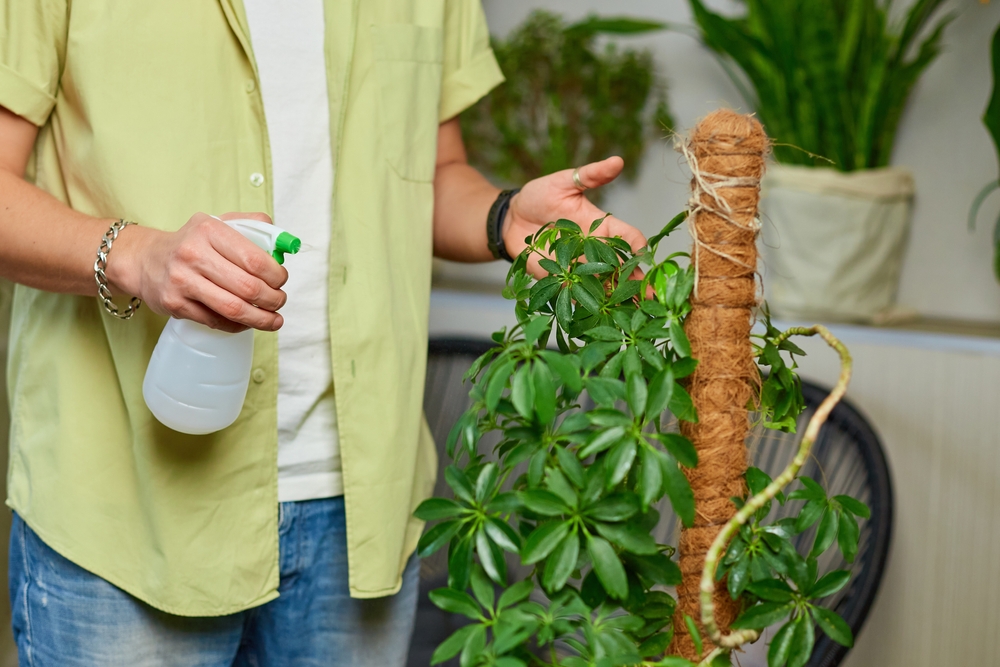Schefflera plants, also known as umbrella plants, are popular houseplants that can add a touch of greenery to any home. However, if your schefflera plant is starting to show signs of dying, it can be concerning.
Understanding the common signs and causes of Schefflera Plant Dying can help you take the necessary steps to revive it and prevent future issues.
One of the most common signs of a dying schefflera plant is yellowing leaves. This can be caused by a variety of factors, including overwatering, underwatering, low humidity, or pest infestations.
Additionally, if the leaves are drooping or falling off, this can also be a sign that your schefflera plant is struggling. By identifying these symptoms early on, you can take action to save your plant before it’s too late.
If you’re experiencing issues with your schefflera plant, don’t worry – there are steps you can take to revive it. By addressing root and foliage problems, adjusting watering and humidity levels, and providing proper care, you can help your schefflera plant thrive once again.
With a little patience and TLC, your schefflera plant can continue to bring beauty and life to your home for years to come.
Key Takeaways on Schefflera Plant Dying
- Common signs of a dying schefflera plant include yellowing leaves, drooping foliage, and pest infestations.
- Causes of schefflera plant dying can include overwatering, underwatering, low humidity, and pest infestations.
- To revive a dying schefflera plant, address root and foliage problems, adjust watering and humidity levels, and provide proper care.
Also don’t miss:
Understanding Schefflera Plant

Schefflera plants, also known as umbrella plants, are tropical plants native to Taiwan and Hainan. They are popular indoor plants due to their low maintenance and tolerance to various conditions. Schefflera plants can grow up to 8 feet tall and have large, glossy leaves that resemble umbrellas, hence the name.
Schefflera plants are easy to care for and can thrive in a variety of light conditions, from low to bright indirect light. They prefer well-draining soil and should be watered only when the top inch of soil is dry. Overwatering can cause root rot and lead to the plant’s death.
Umbrella plants are also known for their air-purifying qualities, making them a great addition to any indoor space. They can remove harmful toxins from the air, such as formaldehyde and benzene.
Schefflera plants are generally hardy, but they can be susceptible to pests such as spider mites and mealybugs. Regular inspection and treatment with insecticidal soap can prevent infestations.
Common Signs of a Dying Schefflera Plant
Schefflera plants are known for their lush green foliage and are a popular choice for indoor decor. However, like any other plant, Schefflera plants can also suffer from various problems that can lead to their death. Here are some common signs that indicate a Schefflera plant is dying:
1. Yellowing Leaves
Yellowing leaves are one of the most common signs of a dying Schefflera plant. This can be caused by a variety of factors, including overwatering, underwatering, or exposure to extreme temperatures.
Overwatering can lead to waterlogged soil, which can cause the roots to rot and prevent them from absorbing nutrients properly. On the other hand, underwatering can cause the leaves to dry out and turn yellow.
2. Brown Leaves

Brown leaves are another sign that a Schefflera plant is in distress. This can be caused by the same factors that cause yellowing leaves, but it can also be a sign of pest infestation. Spider mites and mealybugs are common pests that can damage Schefflera plants and cause the leaves to turn brown.
3. Drooping Leaves
Drooping leaves are a sign that a Schefflera plant is not getting enough water. This can be caused by underwatering or a lack of humidity. Schefflera plants prefer a humid environment, and if the air is too dry, the leaves can start to droop and curl.
4. Stunted Growth
Stunted growth is a sign that a Schefflera plant is not getting enough nutrients. This can be caused by a lack of fertilizer or poor soil quality. Schefflera plants require regular fertilization to grow properly, and if they are not getting enough nutrients, they may become stunted and fail to thrive.
Schefflera Plant Dying – 4 Common Problems
Schefflera, also known as umbrella plants, are popular houseplants due to their low maintenance nature. However, they can still experience issues that cause them to die. In this section, we will discuss the most common causes of Schefflera plant dying.
Overwatering and Underwatering
Overwatering and underwatering are two of the most common reasons why Schefflera plants die. Overwatering can lead to root rot, which prevents the plant from absorbing water and nutrients properly.
On the other hand, underwatering can cause the leaves to wilt and drop off. It is important to find the right balance when watering Schefflera plants.
It is recommended to wait until the soil dries out before watering the plant. One way to check if the soil is dry is to stick your finger into the soil up to the second knuckle. If the soil feels dry, it is time to water the plant.
Inadequate Light Conditions

Schefflera plants require bright, indirect light to thrive. If they are kept in low light conditions, the plant may become weak and susceptible to disease. On the other hand, if they are exposed to direct sunlight, the leaves may scorch and turn brown.
It is recommended to place Schefflera plants in a location that receives bright, indirect light. If the plant is not receiving enough light, consider moving it to a brighter location or supplementing with artificial light.
Temperature Stress
Schefflera plants prefer warm temperatures between 60 and 75°F. If they are exposed to temperatures below 50°F, they may experience temperature stress and die.
It is recommended to keep Schefflera plants in a location with a consistent temperature between 60 and 75°F. Avoid placing them near drafty windows or doors that can cause temperature fluctuations.
Pest Infestation
Pests like spider mites, scale, mealybugs, and aphids can cause Schefflera plants to die. These pests can weaken the plant by sucking the sap out of the leaves and stems.
It is recommended to inspect the plant regularly for signs of pest infestation. If pests are detected, it is important to treat the plant with an appropriate insecticide. Ants are also attracted to the sweet honeydew produced by these pests, so it is important to eliminate them as well.
Root and Foliage Problems

Schefflera plants are susceptible to a variety of root and foliage problems. Knowing how to identify and treat these problems is essential for keeping your plant healthy.
Root Rot
One of the most common problems with Schefflera plants is root rot. Overwatering or poor drainage can lead to waterlogged soil, which in turn causes the roots to rot. Signs of root rot include yellowing leaves, wilting, and a foul smell emanating from the soil. If left untreated, root rot can kill the plant.
To treat root rot, it is important to identify the problem early. Remove the plant from its pot and inspect the roots. Healthy roots should be white or light brown and firm to the touch. If the roots are brown, black, or mushy, they are likely rotting. Cut away any damaged roots and repot the plant in fresh, well-draining soil.
Fungal and Bacterial Diseases
Schefflera plants can also be affected by fungal and bacterial diseases. These diseases can cause yellowing or browning of the leaves, wilting, and stunted growth.
Fungal diseases like powdery mildew can be identified by a white, powdery coating on the leaves. Bacterial diseases like bacterial leaf spot cause small, water-soaked spots on the leaves.
To treat fungal and bacterial diseases, it is important to remove any affected leaves and improve the plant’s growing conditions. Increase air circulation around the plant, avoid getting the leaves wet when watering, and make sure the plant is not overcrowded. In severe cases, fungicides or bactericides may be necessary.
Leaf Spot
Leaf spot is another common problem with Schefflera plants. Leaf spot is caused by a fungal or bacterial infection and can cause small, circular spots on the leaves. As the disease progresses, the spots may merge and cause the leaves to yellow and fall off.
To treat leaf spot, remove any affected leaves and improve the plant’s growing conditions. Increase air circulation around the plant, avoid getting the leaves wet when watering, and make sure the plant is not overcrowded. Fungicides or bactericides may be necessary in severe cases.
Reviving a Dying Schefflera Plant

Schefflera plants are known for their unique umbrella-like leaves and are becoming more and more popular in the houseplant world. They tend to be easy to take care of and don’t require much space in your home compared to some other houseplants.
However, if you notice your Schefflera plant is dying, it’s important to take action to revive it. Here are some tips to help you get started.
1. Proper Watering
Overwatering is one of the most common reasons for an umbrella plant to die. Schefflera plants are native to tropical regions and do not like to be waterlogged.
To avoid overwatering, make sure the soil has good drainage and the pot has drainage holes. Completely waterlogging the plant or drying out the soil stresses the plant. Water your Schefflera consciously and only when the top inch of the soil feels dry.
2. Optimal Light and Temperature Conditions
Schefflera plants prefer bright, indirect light. Direct sunlight can scorch the leaves, while low light conditions can cause the plant to become leggy. Maintain a temperature range of 65°F and 75°F (18°C and 24°C) and avoid exposing the plant to extreme temperatures.
3. Pest Control
Insects and pests can also cause a Schefflera plant to die. Common pests that attack Schefflera plants include spider mites, mealybugs, and scale insects. To control these pests, use insecticide or neem oil. It’s important to follow the instructions on the label carefully to avoid damaging the plant.
4. Pruning and Repotting
Pruning and repotting can also help to revive a dying Schefflera plant. Prune the plant to remove any dead or damaged leaves, stems, or roots. Repot the plant in fresh potting mix if you suspect root rot. Make sure the new pot is slightly larger than the previous one to allow the roots to grow.
5. Humidity
Schefflera plants prefer high humidity, but they can also tolerate low humidity. If the air in your home is dry, consider using a humidifier or placing a tray of water near the plant to increase the humidity. Regular misting of the leaves can also help to maintain the humidity around the plant.
Best Practices for Schefflera Plant Care

Nutrition and Soil
Schefflera plants require a balanced diet of nutrients to thrive. The best way to ensure that your plant receives the necessary nutrients is by using a high-quality potting soil that is rich in organic matter. The soil should be well-draining and airy, as Schefflera plants are susceptible to root rot if they are overwatered.
To provide your Schefflera plant with the necessary nutrients, you can use a slow-release fertilizer that is specifically formulated for indoor plants.
Alternatively, you can use a liquid fertilizer that is diluted in water and applied to the soil every two weeks during the growing season. It is essential to follow the manufacturer’s instructions when using any fertilizer.
Drainage
Good drainage is critical for Schefflera plants. The soil should be well-draining, and the pot should have drainage holes to allow excess water to escape. If the pot does not have drainage holes, you can add a layer of stones or pebbles to the bottom of the pot to improve drainage.
To prevent root rot, it is crucial to avoid overwatering your Schefflera plant. Water the plant only when the top inch of soil feels dry to the touch. It is better to underwater than overwater your Schefflera plant.
Airflow and Environment
Schefflera plants require good airflow and a stable environment to thrive. Avoid placing your plant in drafty areas or near air conditioning vents or heating sources. The ideal temperature range for Schefflera plants is between 60 and 75 degrees Fahrenheit.
To improve airflow around your Schefflera plant, you can use a small fan to circulate the air. Additionally, you can place the pot on a pebble tray filled with water to increase humidity levels around the plant.
Preventing Future Issues
To prevent future issues with Schefflera plants, there are several preventive measures that can be taken. One of the most important is to ensure that the plant is well cared for and receives the necessary nutrients and water.
Schefflera plants are low maintenance and do not require frequent watering, but it is important to keep the soil moist and not to let it dry out completely.
Another common issue that can affect Schefflera plants is transplant shock. When transplanting, it is important to be gentle and avoid damaging the roots. Additionally, the plant should be placed in a location with moderate light and protected from cold drafts or direct sunlight.
Cold damage is another common issue that can affect Schefflera plants. To prevent this, it is important to keep the plant in a warm location and protect it from cold drafts. If the plant is exposed to cold temperatures, it may experience leaf drop or other damage.
Mold and foul smells can also be a problem with Schefflera plants. To prevent this, it is important to keep the soil moist but not waterlogged. Additionally, it is important to ensure that the pot has drainage holes and to avoid overwatering.
Pathogens can also be a problem with Schefflera plants. To prevent this, it is important to keep the plant healthy and free from pests and diseases. Using a moisture meter can help ensure that the plant is not over or under-watered, which can make it more susceptible to pathogens.
When caring for Schefflera plants, it is important to remember that they are indoor plants and require a specific environment to thrive. They should be kept in a location with moderate light and protected from cold drafts or direct sunlight. Additionally, trimming the plant regularly can help promote healthy growth and prevent sticky leaves.
If the plant does experience issues with pests or diseases, there are several remedies that can be used. Rubbing alcohol can be used to remove mealy bugs, while cuttings can be taken to propagate new plants. Regular trimming can also help prevent the spread of pests and diseases.
Frequently Asked Questions

Why are my schefflera leaves turning brown and falling off?
Brown and falling leaves are usually a sign of overwatering or underwatering. The first thing to check is the soil moisture. Stick your finger in the soil and water only when the top inch of the soil is dry.
Make sure the pot has proper drainage and the soil is well-draining. Also, avoid placing the plant in direct sunlight or cold drafts.
How to save a dying umbrella plant?
To save a dying umbrella plant, you need to identify the problem first. Check the leaves for any signs of pests or diseases. If you find any, treat the plant with a suitable insecticide or fungicide.
Check the soil moisture and adjust watering accordingly. If the plant is rootbound, repot it in a larger container with fresh soil. Prune any dead or yellowing leaves and stems to promote new growth.
Will my umbrella plant grow back?
If your umbrella plant has lost most of its leaves or stems, it may not grow back. However, if the plant still has some healthy leaves and stems, it has a good chance of regrowing. Make sure to provide the plant with proper care, including adequate light, water, and nutrients.
Schefflera on lava dying?
Schefflera plants can grow in lava rock, but they require proper care and maintenance. If your schefflera on lava is dying, check the soil moisture and adjust watering accordingly. Make sure the plant is getting enough light and nutrients. If the plant is rootbound, repot it in a larger container with fresh soil.
Umbrella plant stem turning black?
Black stems on umbrella plants can be a sign of root rot or stem rot. This can be caused by overwatering, poor drainage, or a fungal infection. To save the plant, remove any affected leaves or stems and treat the plant with a suitable fungicide. Adjust the watering schedule and make sure the soil is well-draining.
How do you save a rotting umbrella plant?
To save a rotting umbrella plant, you need to act quickly. Check the plant for any signs of pests or diseases, and treat it accordingly. Remove any affected leaves or stems and prune the plant to promote new growth.
Repot the plant in a larger container with fresh soil, and make sure the soil is well-draining. Adjust the watering schedule and avoid overwatering.

Hey, I’m Lisa and I’ve been an avid gardener for over 30 years. I love writing, talking and living in the garden! Feel free to connect with me on my socials below


